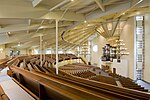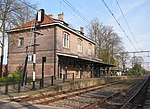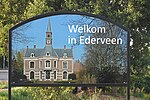Camp Barneveld

Camp Barneveld was an internment camp consisting of two buildings for Dutch Jews near the town of Barneveld, the Netherlands during the German occupation in World War II. Dutch civil servant Karel Frederiks had made an arrangement, later called Plan Frederiks, with the occupiers to keep a small group of Dutch Jews in the Netherlands and exclude them from deportation to the labour, concentration, or extermination camps abroad. At first, in December 1942, a castle called De Schaffelaar was used to house the interned Jews. When De Schaffelaar was full, a nearby large villa called De Biezen and its barracks were added. Although the Nazis did eventually, in September 1943, deport the group of around 650 Jews from Camp Barneveld to Westerbork transit camp and then on to concentration camp Theresienstadt in Bohemia, almost all survived.
Excerpt from the Wikipedia article Camp Barneveld (License: CC BY-SA 3.0, Authors, Images).Camp Barneveld
Jan Seppenplein, Barneveld
Geographical coordinates (GPS) Address Nearby Places Show on map
Geographical coordinates (GPS)
| Latitude | Longitude |
|---|---|
| N 52.133333333333 ° | E 5.5833333333333 ° |
Address
Jan Seppenplein 9
3772 BL Barneveld
Gelderland, Netherlands
Open on Google Maps










